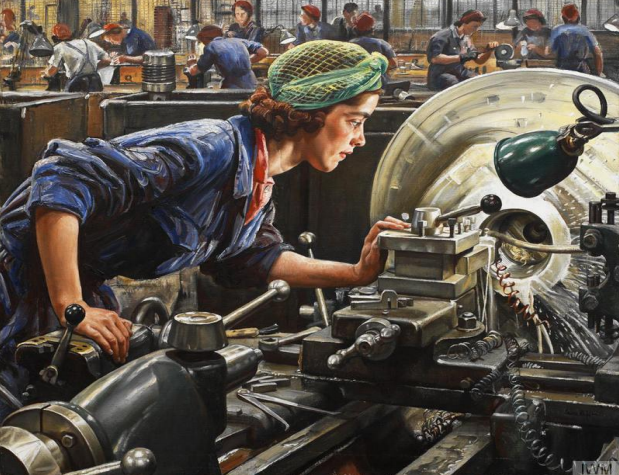Spot The Safety Violation: Take 6 Steps to Protect Workers? Eyes
What important piece of PPE should the factory worker in this painting be wearing’

May is Vision Health Month in Canada. Workplace injury is a leading cause of eye trauma, vision loss, disability and blindness. So what can employers do to protect workers’ eyes and sight’ Among other things, employers can ensure that workers wear appropriate PPE when using equipment or doing jobs that pose a safety hazard to their eyes or vision.
This painting by Laura Knight is a portrait of an actual British factory worker, Ruby Loftus, who worked at the Royal Ordnance Factory during World War II. It depicts her operating a lathe.
Loftus was considered an outstanding factory worker, who’d mastered complex engineering skills in a very short space of time. Unfortunately, she’s endangering her eyes by not wearing proper eye protection while operating this machinery. In fact, if you look at the workers in the background of the painting, you’ll see that none of them appear to be wearing any eye protection.
TAKE THESE 6 STEPS
To protect workers’ eyes and vision and ensure you comply with the requirements for eye protection in the OHS laws, take these six steps and implement a face and eye protection policy:
Step #1: Determine if there’s a risk of injury to workers’ eyes. Could they be exposed to dust, fibres, flying particles, tree branches, splashing fluids, radiation, etc.’ For example, there’s a risk of an eye injury to the worker in the painting caused by materials kicked up by the lathe she’s operating.
Step #2: Decide if you can eliminate or control these hazards. If you identify any hazards to workers’ eyes, you want to eliminate or control them first, such as by installing screens or guards around equipment to protect workers from flying particles or splashing liquids. You can also implement administrative measures, such as requiring workers to wet surfaces to keep down dust.
Step #3: Select appropriate eye protection. If you can’t eliminate or control the eye hazards, determine the appropriate kind of eye protection to shield workers from them. Which type of eye protection is appropriate will depend on the nature of the eye hazard. There are seven basic classes of eye protection:
-
- Spectacles;
- Goggles;
- Welding helmets;
- Welding hand shields;
- Non-rigid helmets or hoods;
- Face shields; and
- Respirator facepieces.
Once you’ve selected the appropriate eye protection, make sure that it’s available to all of the workers who need it, such as the factory workers in the painting.
Step #4: Ensure workers use eye protection properly. Once you’ve selected appropriate eye protection and provided it to workers, make sure that they use it correctly. For example, eye protection should fit workers properly and not obscure their vision. (Finding properly sized PPE can be particularly challenging for female workers.)
Step #5: Make sure workers properly maintain their eye protection. If workers don’t maintain their eye protection, it won’t adequately protect their eyes. So ensure that workers inspect their eye protection for any damage or defects before using it, clean it when needed and properly store it.
Step #6: Train workers. As with any PPE, make sure to train workers on eye protection, including when it’s needed, how to use it and how to maintain it.
In addition, you may want to have eyewash stations available in the workplace in the event that workers get something in their eyes despite wearing eye protection. Being able to immediately flush dust, chemicals and other irritants out of their eyes may minimize any injuries and help save workers’ vision.